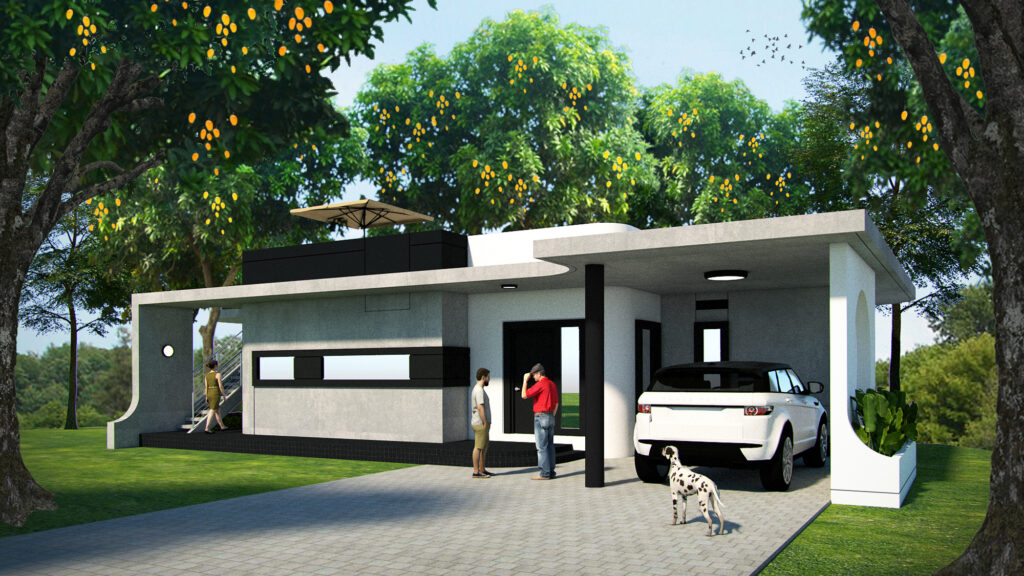
BIOCO HOUSE
Location: UMINGAN, PANGASINAN, PHILIPPINES
Floor Area: 343.00 SQ. M.
Completion Year: 2024
The aim of the project was to design a house that has strong connection with the environment, a house that is functional and comfortable for a retiring couple who looks forward for the next chapter of their lives. The name bioco is a combination of words “bio” and “co” which means life and coexistence, bioco is also a variety of mango with small fruit but extraordinarily sweet when ripe – small but sweet.
The site is on a rolling terrain part of the province with a few minutes drive from the town with mountain views and simultaneously large open grassland and clumps of trees. The site is about half a hectare of property with the house situated on the highest portion of the lot overlooking a field, river, and an old pond. The house is surrounded by several mango trees in which the owner and the architect ought not to be cut but rather embraced, creating a unique opportunity to build a house that is in close harmony with nature.
After working tirelessly abroad the couple wanted to see the fruits of their labor by building a house of their own and where they could spend time together. The couple intended to build a house not only for themselves but also to accommodate families and friends where they can share and build memories for years to come, the house features a living area next to main kitchen and dining area all in one large space where the couple can entertain guest easily and even larger al fresco space on the roof deck and extra two bedrooms for occasional sleep-over.
The challenge is how to make a building work without disrupting or cutting the trees around it. The architect and engineers need to work together to be able to design a house specifically for the site. The foundation needs to be carefully planned so as not to hurt the trees during the process of construction. Thankfully, the trees are already mature enough to not provide substantial growth as it may affect the house. The project mainly used reinforced concrete for its structure because of its durability and longevity. Majority of the project’s finishes are in exposed concrete because of its strength, low maintenance, and cost efficiency; polished concrete for floors and counters, exposed concrete for walls, and some ceiling surfaces.
The house has a roof deck which can be used for large social gatherings. The roof deck is a multi-functional space of the house; it is a place where owners and visitors are high up the ground and can easily reach tree branches and occasionally pick varieties of surrounding mangoes, a place where you can hear birds chirping, a viewing deck with 360-degree view of trees and bodies of water on its side, a place to breath fresh air, a place where forest like immersion can only give.
The architect designed the house to be sustainable but also cater to the immediate needs of the occupant. All artificial lights used in the house are LED which is low in electric consumption and lower heat emission. Windows are all present in all spaces of the project for natural light and cross-ventilation. The entire house features a naturally ventilated roof area through louvers placed according to the prevailing wind of the site allowing the space above the ceiling to cross ventilate and not allowing heat to be trapped within the space. The house was designed to have even floor elevations to navigate the spaces with ease even with eyes closed. Garage, toilet, and laundry floors are all non-skid surfaces including spaces like the stairs and roof deck. The architect designed the house not only to be environmentally conscious but also comfortable, user friendly, and safe.
At glance the house exudes simplicity with curvilinear walls and details mimicking the organic nature of a mango tree and its fruit. There is an outdoor stair on the left side of the house when ascended provides better views which can provide excitement for newcomers. The house features a large canopy on its façade and ledges around it to prevent heat absorption from afternoon sun and water intrusion during the rainy season. The laundry area and service kitchen were placed facing the sun and served as a heat barrier where those spaces are seldom used in the afternoon. The house features large windows on the eastern side of the house to take advantage of the morning sun and the vistas of the property. The architect chose monochromatic tones with the use of humble concrete finishes. Avoiding vibrant color schemes makes the spaces visually silent and was the key to emphasize the people more than the space itself. The house sits to frame the life of people where they can perform life’s drama with a curtain of trees as a backdrop.
